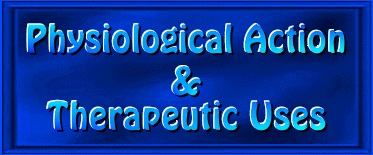


The following is excerpted from The Professional's Herbal Formula Handbook No. 17, comprising 100 pages of traditional information and recent scientific data that describes the medical properties, physiological action and therapeutic uses for each of the 24 ingredients outlined in this formula.




Adaptogenic, alterative, anabolic, anti-aggregant, anti-cachexic, anti-catarrhal, anti-coagulant, anti-dyscratic, anti-infective, antioxidant, antiphlogistic (anti-inflammatory), anti-scorbutic, antiseptic, antispasmodic (vascular), anti-thrombotic, astringent, bacteriostatic (anti-bacterial), cholagogue, choleretic, cytophylactic, cytotoxic, decongestant, depurative, detoxicant, diaphoretic, disinfectant, diuretic, expectorant, hemostatic, hypotensive, microbicidal (anti-microbial), purgative, rejuvenative, restorative, sedative (arterial), spasmolytic, stimulant (circulatory and secretolytic) and tonic.


Alleviates any general fluids dyscrasia (abnormal or pathological condition) within the blood vessels (arteries, veins and capillaries) throughout the entire circulatory system (as well as the mucous membranes or tissue-systems throughout the entire organism) that leads to the onset of various degenerative or debilitative conditions associated with various circulatory system imbalances (including anemia, arrhythmia, arteriopathy, capillary engorgement, capillary fragility, capillary permeability, cardiac hypoxemia, cardiovascular erethism, coronary sclerosis or thrombosis, fatigue, global parasympathetic inhibition, hypercholesterolemia, hyperlipidemia, hypoxia, peripheral circulatory insufficiency, sepsis (blood poisoning), blood or capillary stasis, venous insufficiency, and general weakness), and eliminates any cachexia (state of malnourishment and general debility) throughout the entire organism in order to provide increased protection against any systemic or localized nutritional deficiencies or insufficiency that leads to various circulatory system disorders; acts as a secretolytic stimulant in order to promote increased gastric, pancreatic or intestinal secretory and motor activity, and enhances greater peripheral circulation (due to its antioxidant activity); exhibits significant antioxidant effects in order to provide greater oxygen-transport capabilities throughout the entire circulatory and cardiovascular systems, as well as enhance the transport of additional oxygen directly into the cells and tissue-systems throughout the blood vessels (arteries, veins and capillaries); acts as a circulatory stimulant by increasing the blood flows throughout the circulatory system in order to enhance greater nutrient transport, absorption and utilization, thereby accelerating the healing processes associated with the repair of any nutritional deficiencies or insufficiency throughout the entire organism; removes any indurations in the veins, and acts as a restorative in order to eliminate any weakened or sluggish circulatory flows; stimulates the nerve-endings that lead directly to the heart muscle and blood vessels, due to the presence of the iridoid glucoside verbenalin (which splits into verbenalol and hastatoside); inhibits the sympathetic nerve-endings in the epidermal mucous glands of the heart and blood vessels, due to the presence of the glucoside verbenin; exhibits hemostatic activity in order to more rapidly reduce the blood-clotting time, and acts as an anti-coagulant and hemostatic in order to remove any venous blood stasis (stagnation); displays significant anti-aggregant, anti-coagulant and anti-thrombotic activity (due to the presence of verbenalin) in order to prevent blood platelet aggregation or blood clotting by inhibiting any further exposure of the fibrinogen receptors located on platelet membranes, thereby enhancing greater overall effectiveness against the onset of atheriosclerosis; exhibits arterial sedative, vascular antispasmodic, hypotensive and spasmolytic effects in order to relax the smooth muscles throughout the cardiovascular system, thereby removing any spasmodic contractions or tension in the blood vessels; demonstrates hypotensive activity in order to dilate the coronary blood vessels, thereby relieving any vasospasmsasodilatory activity through the mechanism of calcium-channel antagonism (calcium-channel blockers) that leads to angina or hypertension; displays choleretic and cholagogue properties in order to remove any intestinal putrefaction or septicemia, which ultimately leads to the development of autointoxication (auto-toxemia) throughout the arterial, venous and capillary systems; exhibits astringent properties in order to strengthen the functional capabilities of the spleen (which is responsible for filtering the blood and releasing compounds that potentiate immune function), thereby maintaining proper blood supplies within the arteries, blood vessels and capillaries throughout the entire circulatory system; displays anti-catarrhal and expectorant properties in order to accelerate and strengthen the functional capabilities of the entire expectoration process, thereby facilitating the loosening and expulsion of any excessive gummy or viscid mucoid or phlegmatic accumulations from the entire circulatory and cardiovascular systems (including the blood vessels and coronary arteries); provides greater biochemical resistance against any infectious conditions in the bloodstream or tissue-systems, due to the presence of saponins and tannins; exhibits cytophylactic and cytotoxic activity in order to provide stronger cellular defense mechanisms against many physical or chemical agents, and displays anti-infective and disinfectant properties in order to promote increased resistance by destroying any invasive or harmful pathogenic bacteria, microbes or viruses that are often responsible for various infectious states or inflammatory conditions; exhibits bacteriostatic and microbicidal activity in order to strengthen and increase the resistance of the circulatory system against any invasive or harmful bacteria or microbes, as well as to inhibit the further development of any infectious or inflammatory conditions associated with the onset of various circulatory system disorders; demonstrates significant antiphlogistic effects in order to inhibit the formation of certain inflammatory compounds (such as histamine, leukotrienes, prostaglandin, serine proteases and thromboxanes), as well as to reduce any severe inflammatory swelling associated with any degenerative conditions by exerting an extremely positive influence towards correcting any internal inflammatory conditions throughout the entire circulatory system (including the arteries, veins and capillaries); exhibits significant antiseptic activity by destroying the vitality of any organized living ferments in order to prevent the onset of putrefaction or septicemia, and precipitates the proteins in any inflamed tissues in order to provide a mildly antiseptic and protective coating (under which the regeneration of new tissue occurs) for the mucous membranes and tissue-systems throughout the entire circulatory system; acts as an effective antiseptic in order to remove any septic conditions associated with tissue degeneration or ulceration, and promotes increased suppuration and a steady toning or restorative impression to the entire glandular system (especially the liver, spleen and lymph glands); exhibits anabolic activity in order to accelerate the production of DNA and RNA (which enhances the production of proteins in the form of antibodies), while increasing protein and lipid synthesis in the bone marrow and DNA/RNA content in the adrenals and lymph nodes (along with increased body weight and enhanced re-synthesis of glycogen and high-energy phosphate compounds); demonstrates powerful adaptogenic (balancing and strengthening) activity in order to increase the overall resistance of an organism towards any adverse influences or stressful conditions (whether they be physical, chemical or biological), especially throughout the immune system, blood vessels, musculature, skeletal structure, and both the central (cerebro-spinal centers) and peripheral nervous systems; demonstrates significant rejuvenative and restorative properties upon the basic plasma tissue-systems throughout the entire organism, thereby enhancing the production of vital bodily fluids while providing greater enrichment through increased assimilation of the various organic mineral salts; accelerates the recuperative processes that are essential in order to overcome any chronic degenerative or debilitative diseases or illnesses, while facilitating greater recovery response during convalescence in order to fully regain optimal health and well-being; strengthens and tonifies the entire cardiovascular and circulatory systems, and promotes increased peripheral (capillary) circulation; activates the bodily processes of detoxification and elimination in order to cleanse and purify the bloodstream and tissue-systems, and increases both sensible and insensible perspiration in order to more effectively enhance the eliminative capabilities of the body (while increasing the secretion and elimination of urine in order to provide further support to the inner cleansing process); displays alterative activity in order to correct any disordered bodily function, thereby activating increased alterations in both metabolic and tissue functions as a defensive measure against the onset of acute or chronic disease; exhibits restorative effects in order to regain increased vigor or vitality and greater strength, while enhancing normal tissue and metabolic functional capabilities; demonstrates alterative and restorative properties in order to re-establish healthy systemic functional capabilities, as well as to establish greater vascular tone throughout the entire organism (due to its ability to stimulate increased secretory flows); exhibits alterative effects in order to stimulate the anabolic growth processes, thereby enhancing the repair of any degenerated, deteriorated and debilitated cells or tissues (while promoting the elimination of any catabolic waste materials); displays tonifying effects in order to permanently enhance the overall energy-levels throughout the entire organism, without adversely affecting the functional capabilities of any particular organ or system.
![]()
None.
![]()